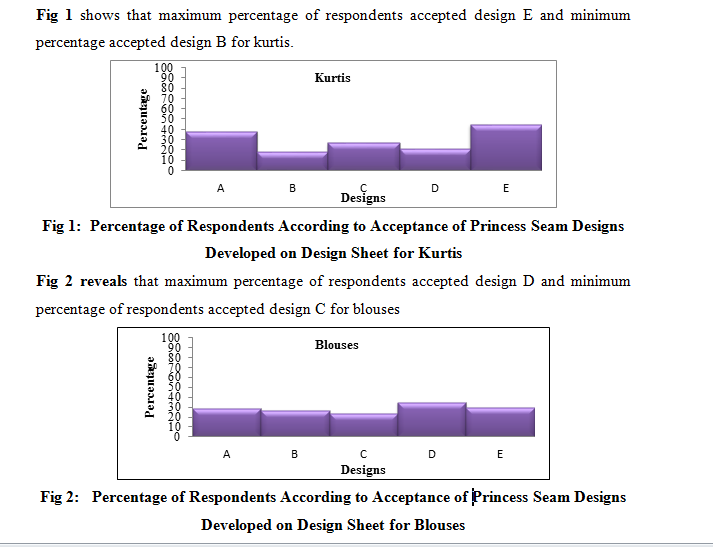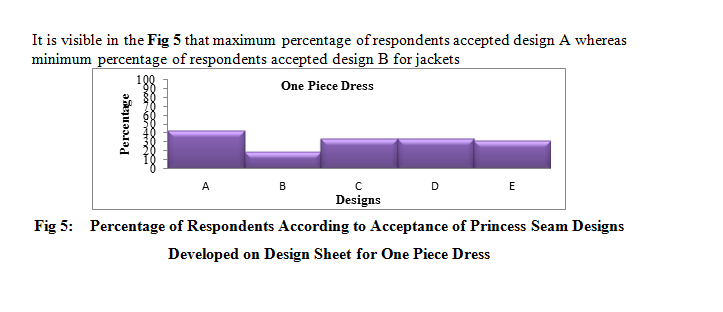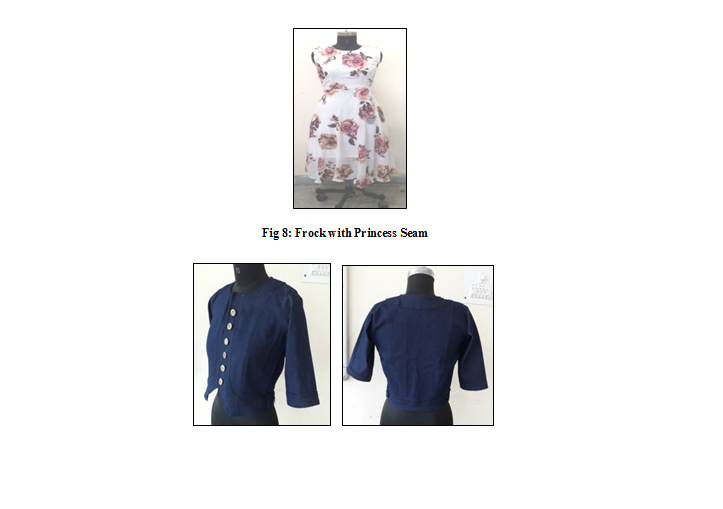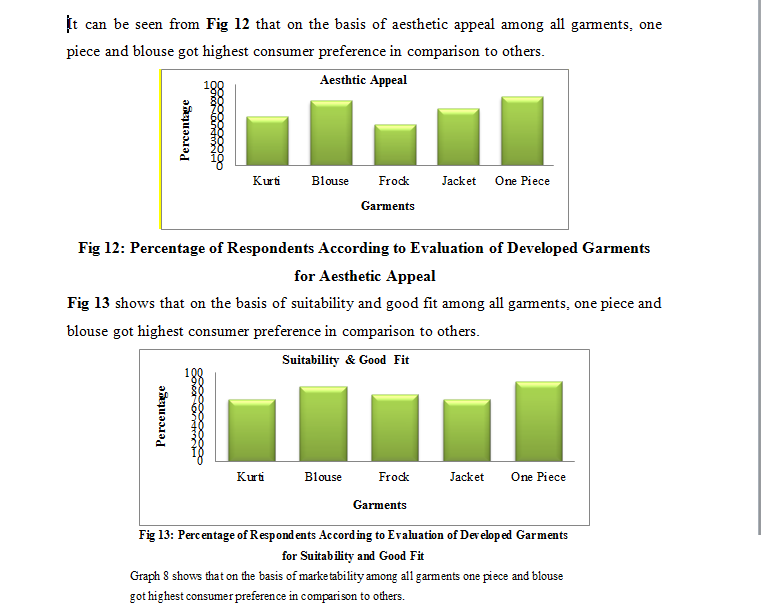Alleviation: An International Journal of Nutrition, Gender & Social Development, ISSN 2348-9340
Volume 4, Number 4 (2017), 1-9
© Arya PG College, Panipat & Business Press India Publication, Delhi
www.aryapgcollege.com
Development of Garments Using Princess Seam
Introduction
Princess seams are long round seams sewn into garments to add shaping or a tailored fit to closely follow an individual shape. They are sewn into the front and/or back of a garment, and extended from the waist up to the arms. Princess seams are distinct from darts in that they form a continuous line and are a full seam. Darts, on the other hand are folds sewn into the clothing to shape the resultant garment. These are kind of controlled wrinkle. Princess seams are usually used specifically in women's fashion, since these are designed to make a garment fit smoothly and snugly. Many formal fitted garments, such as formal gowns, are made with this seam, and as a general rule, the seams are used instead of darts.
fitted waist bodice with vertical seams, rather than dart, is known as the princess bodice. These vertical seams divide the bodice into separate panels. When these seams are sewn together, they take on the same shape as the basic bodice, but with vertical seams. Design can also be created through princess seams with an unbroken style lines that usually extends from the shoulder and armhole to the waistline. This style line almost always crosses over the midpoint of the bust line (apex) and replace the need for darts. A princess bodice back should always be designed similarly to the chosen front princess bodice.
Princess seams are a variation of darts, the creation of a fitted garment through the use of shaped seams. They start at the waist and travel towards the most prominent part of the body in that quadrant of the garment. For example, on a bodice front, they travel over or near the bust point, while on the bodice back; they travel over or near the shoulder blades. Though less common, skirt or pants princess seams start at the waist and travel over or near the fullest part of the abdomen and/or near the fullest part of the buttocks.
Because the seam always starts at the waist, names of princess seam styles refer to the ending point. Two classic styles of princess seams are (a) shoulder and (b) armhole. A princess seam can start almost anywhere in the neckline or in the centre front, depending on the garment design.
There are many variation to a princess style. When princess seams are used on the front of a garment, they run over the line of the bust to create an even and smooth look. They usually descend down the front of the garment, gathering the fabric to highlight a slender waist and flaring back out again at the hips. The seams on the back of a garment do essentially the same thing, starting wide at the shoulders and curving in before flaring at the hips.
• There are a number of applications for such seams. On slender and thin women, they can be used to highlight the figure, and provide the illusion of curves. Women with classical hourglass figures often find that princess seams emphasize the thin waist in a way that many people find aesthetically pleasing. On fuller figured women, they can be adjusted to fit an ample bosom and hips, creating an aesthetically pleasing garment. Many plus size manufacturers use these seams for this reason. Making a garment with princess seams require the use of a pattern that has been specifically designed for this type of construction. These patterns can be easily adjusted to fit various figures.
The present study will be helpful to create new creative fitted garments with princess seams, so it was undertaken with the following objectives :
• To collect designs through different sources like magazines, book, net and other.
• To develop 25 designs though coral draw and evaluate these designs in different garments (kurtis, blouses, frocks, jackets and one piece dress) on the basis of acceptability, marketability, aesthetic appeal, suitability and good fit.
• To develop selected five final garments.
• To access the acceptability and marketability.
Following were the delimitations of the study:
• Designs were developed by corel draw.
• Only princess seams were used in garment designing.
• Only five garments were developed.
Methodology
This study was divided into three phases:
Phase 1
Selection of designs: Selection of designs for princess seams was for different garments like kurtis, blouses, frocks, jackets and one piece dress on the basis of acceptability, marketability, aesthetic appeal, suitability and good fit.
Locale of study: The study was conducted in department of Home Science, Kurukshetra University, Kurukshetra.
Phase 2
Total 25 designs were developed, five for each (Kurtis, blouses, frocks, jackets, and one piece dress).
Evaluation of developed designs: To select the best five designs, all design sheets were displayed in front of the respondents and evaluated by them on the basis of acceptability, marketability, aesthetic appeal, suitability and good fit.
Analysis of the design sheet: Analysis was done on 5 point rating scale and the best five designs were selected. The score range for each design sheet was from 1 to 5. After that percentages were calculated. In the rating scale, 5 points were given for excellent, 4 for very good, 3 for good, 2 for fair and 1 for average. So the design with highest percentage was selected for development.
Phase 3
Garment construction: Female garments were designed with princess seams.
Assessment of designed garments: Best five garments were assessed based on acceptability, marketability, aesthetic appeal, suitability and good fit.
Results and Discussion
The study was conducted to determine respondents’ attitude towards garments designed with princess seams.



Evaluation of Developed Garments
Developed garments were evaluated by the consumers on the basis of acceptability, marketability, aesthetic appeal, suitability and good fit. Forty respondents were selected for the evaluation. Each of the prepared products was displayed and rating was done on the basis of above mentioned parameters




Conclusion
It was concluded that garments developed were liked by all the respondents and they graded them excellent to very good. Thus the designs evolved by application of princess seam are creative, suitable and accepted by the consumers.
References
Peacock J (2005) The Complete Fashion Source Book. United Kingdom: Thames and Hudson.
Aldrich W (1994) CAD in Clothing and Textiles. New Jersey: Back Well Science Ltd.
Webliography
https://en.wikipedia.org/wiki/Princess_seams.
http://www.sewing.org/html/dartsintro.html.
http://www.fashionera.com/midlate_victorian_fashion.htmhttps://en.wikipedia.org/wiki/Princess_line#References.

